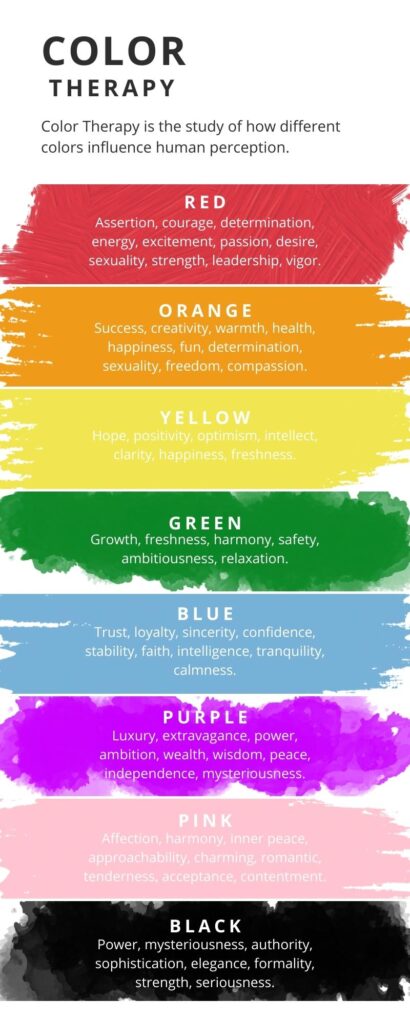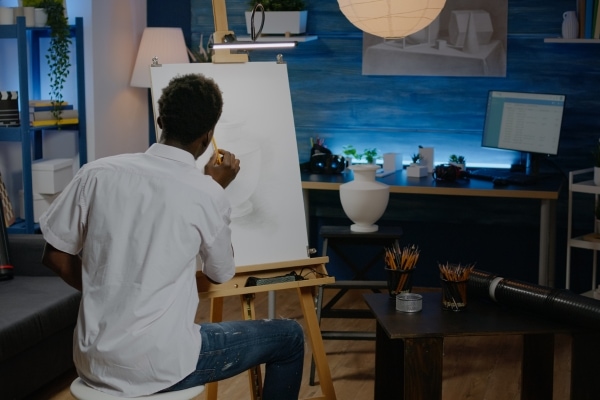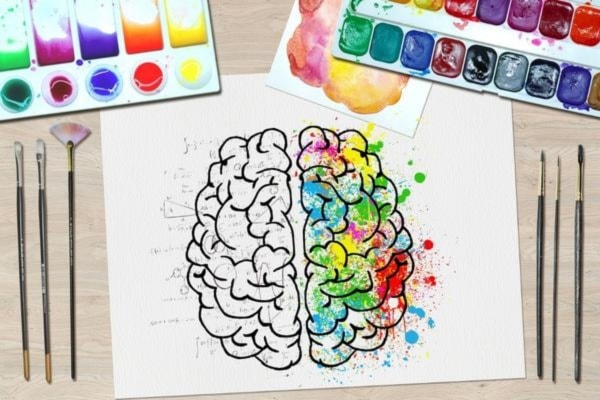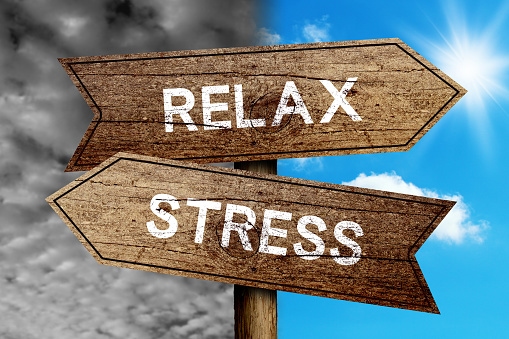”Color is simply energy, and energy made visible. Colors stimulate or inhibit the functioning of different parts of our body. Treatment with appropriate Color can restore balance and normal body functioning,” Laurie Buchanan, PhD.
According to history, color therapy has been practised over the centuries. Greece, Egypt, India and China have practised since ancient ages.
“Our relationship with color has evolved alongside our religion and daily lives”, Walaa AI Muhaiteeb. Color, a manifestation of light, hold divine status to many. For example, Egyptian healers wore blue breastplates to show their sacredness. Athena used to wear a golden robe to signify wisdom and holiness in Greece.
Coloring is now being considered an alternative to medical therapy.
What is Color Therapy?
Color therapy refers to a treatment method that uses visible colors of electromagnetic radiation to cure mental or physical health conditions. It is also known as chromotherapy.
As part of the therapy, a particular color is shined on a particular area of the body. As well, a particular color can be seen through the eyes, but this must be done with utmost care so that the eyes do not strain.
The concept of using colors to influence mood and health dates back to ancient civilizations. However, it’s essential to point out that the scientific backing for color therapy is still in its nascent stages.
Understanding the Concept of Color Therapy
The core principle behind color therapy is the idea that exposure to specific colors can influence an individual’s emotions, mental state, and even their health. This belief stems from the theory of color psychology, which suggests that colors we are exposed to can have a profound impact on our thoughts, reactions, and responses to various stimuli.
Types of Color therapy
Do Colors Have Any Significance in Therapy?
For individuals struggling with mental health disorders, including addiction, color therapy can be a supportive tool. It can be a motivating factor for individuals and can be integrated into a customized treatment plan for the person.
The following are some of the types of color therapy and their significance.
– Blue- Used by color therapists to relieve pain and depression. Darker blue shades have calming properties. It can also be used as a remedy for insomnia and any other sleeping disorders.
– Red- Used to energise people feeling low. Those feeling bored are stimulated. It enhances confidence making one more aggressive.
– Yellow- Used by chromotherapists to improve one’s mood. Yellow will make you happy and optimistic.
– Green- It resembles nature. Exposure to the natural world helps in relieving stress. One’s mind is relaxed and free from anxiety when exposed to green colour. It also signifies peace and prosperity.
– Orange- Has a wide range of benefits. They are used to stimulate happiness. The bright warm color is thought to stimulate food desire and mental activity.
– Brown- Enhances one’s emotional stability.
– Pink- Chemotherapists associate it with sweet emotions, love and romance. They are used in spas to detoxify people.
– Purple- Improves an individual’s creativity, spiritual state and wisdom level.
– Black- Used to improve emotional strength, toughness and authority.
What Makes Coloring So Special for Mental Health?
Coloring serves as a great way to relax your brain. It keeps you in a calm state of mind. During the process, you concentrate on the simple task in front of you. As a result, negative thoughts are kept away from intruding.
Your brain’s ability to function is enhanced. Coloring activates all parts of your brain. Both cerebral hemispheres are involved. Choosing what colors to use starts your creativity. As you color shapes and forms, your logic is triggered. In this way, you gain a deeper understanding of yourself. You gain a clear view of the world around you.
It enables you to maintain a strong positive state of mind. In this way, you can ensure the safety of your mental health.
How do Coloring Mandalas Help in Stress and Anxiety Management?
Mandalas are intricate geometric patterns. They are utilised mainly by adult coloring products. Recent research has been conducted to find out the benefits of adult coloring. Doctors are now convinced that engaging in fine motor movements of the hands has numerous stress reductions.
Fine repetitive movements give one the ability to stay focused on the activity at hand and stay in the present moment.
Dr Herbert Benson states that coloring mandalas lead to a relaxation response due to repetitive movements. They require an adult to put aside arising thoughts and return to the point of focus. He further stated that relaxation response from mandala coloring results in the following.
– Lower heart rate and blood pressure.
– Reduced pulse rate.
– Lower cortisol production-a stress hormone.
A study “can coloring mandala reduce anxiety” was carried out. The author used 84 undergraduate students with anxiety. Twenty minutes of coloring the mandala was more effective than no coloring. Students painting on blank paper showed no reduction in anxiety. However, those who used mandalas decreased their anxiety to below those before they started coloring.
How Does Coloring Help to Reduce Stress and Anxiety?
Color therapy is currently considered an alternative treatment for anxiety. Coloring is capable of relaxing the brain’s fear centre-amygdala. It is necessary after a tiresome and stressful day. It reduces thoughts of a restless mind. It unwinds your fatigue, leaving you with a calm mind free from anxiety.
Relieve from stress and anxiety may decrease your risk of:
–Insomnia.
-Fatigue
-Body aches
-Depression
Benefits of Coloring for Adults
Since time immemorial, chemotherapy has been believed to have a wide variety of benefits. They range from physical to mental, as highlighted.
– Improve sleep- Long-term exposure to emitted light by electronics reduces the level of melatonin. Melatonin is a hormone responsible for sleep. Coloring does not involve electronics. In this way, adults are able to maintain optimal levels of melatonin. As a result, they have a better night’s sleep.
– Improve motor skills and vision- There is an increased rate of electronics use. These electronics limit the involvement of motor skills in their use. Their use focuses only on mental relaxation. With chromotherapy, you get more than just a relaxing effect on your mind. Mandalas have complex designs with little coloring space. They require strict hand-eye coordination and motor skills. As a result, you are able to move more freely and have better vision.
– Improve focus- Coloring requires strict focus. By doing so, you open up your frontal lobe. In this process, problems are organized and solved. It helps you to ignore everything generating a strict focus. This enhances self-awareness and mindfulness.
– Adult coloring revives childhood memories- During our childhood moments, the majority of us spent a lot of time coloring. It was so easy and full of fun. Similar things occur in your adulthood age. When coloring, you must practice a little bit of your old self. You gain enjoyment just as you did as a child.
Children source happiness from simple things. Likewise, you will find joy in simple things like coloring as an adult.
– Induces meditative state-
Adult coloring does not necessarily replace art therapy. Instead, it demands your minds to focus on the complex structure being colored. Meditating in this manner puts your mind at ease.
Meditation begins when you ignore your worries in the past and future. Instead, you focus on the present happenings. Long-term focusing on a singular action such as coloring suspends your fears. As a result, your mind is free from harmful, destructive thoughts.
– Coloring can serve as therapy for some diseases
- Epilepsy- Coloring enhances mindfulness. This decreases the occurrence of an epileptic attack.
- Cancer- Chromotherapy does not offer a direct cure for cancer. However, cancer patients are ever Ill and depressed. Adult coloring benefits the patient positively. It boosts the patient’s health and morale. It helps them to overcome side effects arising from cancer treatment.
– Encourages socialization- You can turn coloring into a social activity by involving your family and friends in your coloring sessions. Friendship and family bonds are enhanced. Researchers have revealed that socialization is suitable for both body and mind. It boosts self-esteem, strengthens your health and relieves stress. A combination of socialization and coloring increases happiness. In addition, it positively contributes to better overall health.
– Energy boosting- Yellow and red are believed to boost your energy. They make you feel motivated. Keep your spirits high by doing this.
Takeaway
Over the years, coloring has been embraced by quite a number of people. Unfortunately, though, western medicine still dismisses the idea. They consider it pseudoscience and quackery.
Coloring does not require expertise or experience to participate. It serves as a cheaper and more effective way to unwind after stressful activities. Select anything you like and color it as you want.
Colors have a real direct biological and psychological impact on people. It is necessary to take advantage of them. We should use them as a remedy for anxiety, energy boosting, meditative state induction and improving focus.












